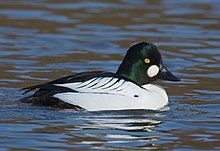Common Goldeneye
| Common goldeneye | |
|---|---|
 |
|
| Adult male | |
 |
|
| Adult female | |
| Scientific classification | |
| Kingdom: | Animalia |
| Phylum: | Chordata |
| Class: | Aves |
| Order: | Anseriformes |
| Family: | Anatidae |
| Subfamily: | Merginae |
| Genus: | Bucephala |
| Species: | B. clangula |
| Binomial name | |
|
Bucephala clangula (Linnaeus, 1758) |
|
| Subspecies | |
(Eurasian goldeneye)
(American goldeneye) |
|
| Synonyms | |
|
Clangula clangula |
|
(Eurasian goldeneye)
(American goldeneye)
Clangula clangula
The common goldeneye (Bucephala clangula) is a medium-sized sea duck of the genus Bucephala, the goldeneyes. Its closest relative is the similar Barrow's goldeneye. The genus name is derived from Ancient Greek boukephalos, "bullheaded", from bous, "bull " and kephale, "head", a reference to the bulbous head shape of the bufflehead. The species name is derived from Latin clangere, "to resound".
Adult males ranges from 45–52 cm (18–20 in) and from 888 to 1,400 g (1.958 to 3.086 lb), while females range from 40–50 cm (16–20 in) and from 500 to 1,182 g (1.102 to 2.606 lb). The species is named for its golden-yellow eye. Adult males have a dark head with a greenish gloss and a circular white patch below the eye, a dark back and a white neck and belly. Adult females have a brown head and a mostly grey body. Their legs and feet are orange-yellow.
Their breeding habitat is the taiga. They are found in the lakes and rivers of boreal forests across Canada and the northern United States, Scandinavia and northern Russia. They are migratory and most winter in protected coastal waters or open inland waters at more temperate latitudes. Naturally, they nest in cavities in large trees. They will readily use nestboxes, and this has enabled a healthy breeding population to establish in Scotland where they are increasing and slowly spreading with the help of nestboxes. They are usually quite common in winter around lakes of Britain and some are being encouraged to nest in nestboxes which are put up to try to have them there all year round. Occasionally recorded as a vagrant in various parts of the Indian Subcontinent.
Often the natural tree cavities are made by broken limbs, unless they are made by pileated woodpeckers or black woodpeckers, the only tree-cavity-making animals who make a cavity large enough to normally accommodate a goldeneye. Average egg size is a breadth of 43.3 mm (1.70 in), a length of 59.3 mm (2.33 in) and a weight of 64 g (2.3 oz). The incubation period ranges from 28 to 32 days. The female does all the incubating and is abandoned by the male about 1 to 2 weeks into incubation. The young remain in the nest for about 24–36 hours. Brood parasitism is quite common both with other common goldeneyes as well as with other duck species, and even tree swallow and European starling eggs have been found mixed with goldeneye eggs. The broods commonly start to mix with other females' broods as they become more independent. Goldeneye young have been known to be competitively killed by other goldeneye mothers, common loons and red-necked grebes. The young are capable of flight at 55–65 days of age.
...
Wikipedia

